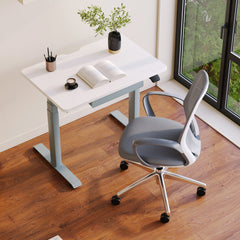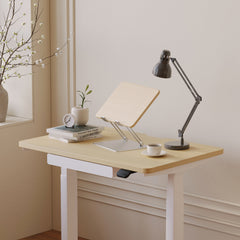Get 10% off your first order
Find the office furniture that’s designed to match your style, comfort, and needs perfectly. Subscribe
Work-Life Balance: Building Healthy Work Habits at Your Desk

Visit quiz page to see how we makes it easy to create an inspiring workplace

 The link between posture and mental clarity is stronger than most people realize. The way you position yourself at your desk influences how deeply you breathe, how your brain processes information, and how alert you feel throughout the day.
The link between posture and mental clarity is stronger than most people realize. The way you position yourself at your desk influences how deeply you breathe, how your brain processes information, and how alert you feel throughout the day.
Good posture isn’t about sitting perfectly still; it’s about balance, awareness, and adaptability. When your workspace is designed to support these qualities, your focus flows naturally, and fatigue becomes a rare visitor.
Let’s explore how better posture and an ergonomic environment can unlock clearer thinking, sharper energy, and a calmer state of mind.
Your brain and body share a constant conversation. When your posture is slouched or strained, blood flow decreases, oxygen intake drops, and concentration wanes. But when you sit upright, your lungs expand fully, and your nervous system operates in balance—improving attention, emotional stability, and creativity.
Increases oxygen and nutrient flow to the brain
Enhances alertness and reaction time
Reduces mental fatigue and tension headaches
Supports balanced mood and motivation
A well-supported body allows your mind to work without resistance.
Awareness begins with how you position your spine and head. Instead of forcing a “perfect” posture, focus on gentle alignment that feels sustainable. A flexible setup like the Small Standing Desk North Carolina lets you move freely between sitting and standing, helping the body reset while maintaining focus.
Keep your monitor at eye level.
Relax shoulders and avoid leaning on your wrists.
Distribute weight evenly between both feet when standing.
Breathe deeply to reduce shoulder tension.
Awareness of posture is a mental exercise—one that trains clarity as much as physical comfort.
An effective workspace isn’t defined by its aesthetics—it’s shaped by how it supports your natural movement. Adjustable furniture like a standing desk helps your body adapt to shifting needs throughout the day, which keeps both your muscles and your mind engaged.
|
Component |
Adjustment |
Mental Benefit |
|
Chair height |
Knees at 90° |
Encourages relaxed focus |
|
Desk surface |
Elbows level with the desk |
Reduces shoulder strain |
|
Screen |
Eye-level placement |
Prevents fatigue and neck tension |
|
Lighting |
Natural and diffused |
Improves concentration and calm |
An ergonomic workspace removes physical obstacles so mental clarity can thrive.
When you slouch, your diaphragm compresses, limiting airflow. Shallow breathing sends stress signals to your brain and reduces focus. By maintaining upright posture, you create space for deeper breaths, improving oxygen supply and mental stamina.
Sit upright with shoulders relaxed.
Inhale slowly through your nose for four counts.
Hold for two seconds, then exhale fully.
Repeat three times before returning to work.
Better posture helps you breathe with intention, giving your mind clarity and calm throughout the day.
Static sitting builds mental fog. Movement increases endorphins and circulation, keeping both mood and motivation high. Alternating between sitting and standing or performing small stretches throughout the day acts like a mental reset button.
Stand up every 45 minutes.
Roll your shoulders and wrists.
Take a brief walk between tasks.
Stretch your neck side to side.
Motion restores energy, improves blood flow, and helps your thoughts flow freely.

Visual clutter translates into mental clutter. A clean surface signals order to your brain, allowing you to focus without distraction. A functional office desk with built-in storage helps you maintain this balance, creating harmony between simplicity and structure.
Keep only daily essentials within reach.
Group small items in trays or drawers.
Use vertical storage to free the workspace area.
End your day with a quick reset routine.
When your desk mirrors mental calm, focus becomes effortless.
Your chair determines how long you can sustain concentration without discomfort. A supportive design that follows your spine’s natural curve encourages movement and reduces strain. Studies have shown that the right chair enhances focus and job satisfaction. You can read more about this connection in this ergonomic study exploring how supportive seating directly impacts productivity and overall mental performance.
Lumbar support for natural curvature
Adjustable seat depth and tilt
Armrests at desk level
Breathable materials for comfort
A good chair doesn’t just improve posture—it nurtures attention and creative flow.
A shared workspace can still support ergonomic comfort when properly designed. A flexible layout like a quad workstation gives each team member their own ergonomic zone while maintaining collaboration.
Encourages healthy posture variety
Minimizes clutter and overlapping equipment
Keeps visual lines open for natural light
Supports focused teamwork through layout balance
When teams work in comfort, communication flows better, and energy levels remain steady.
Posture isn’t fixed—it’s a habit built through daily intention. Making small adjustments consistently can rewire your muscle memory and reshape how you experience focus at work.
|
Time |
Action |
Purpose |
|
Morning |
Stretch for two minutes before sitting |
Wake up your posture muscles |
|
Midday |
Alternate between sitting and standing |
Keep circulation active |
|
Afternoon |
Adjust chair and screen |
Reset alignment |
|
Evening |
Tidy workspace and reflect |
End day with clarity |
When posture becomes part of your daily rhythm, mental clarity follows naturally.
Your desk posture shapes more than physical comfort—it defines how you think, focus, and create. When alignment becomes effortless, your thoughts flow freely, your breathing steadies, and your workspace begins to feel like a source of energy rather than exhaustion.
Clarity is built through awareness.
Movement sustains focus longer than stillness.
Comfort and productivity thrive together.
A supportive environment encourages lasting balance.
When your body aligns with your workspace, your mind aligns with your goals.

A workspace designed for clarity doesn’t have to be complex. It starts with a supportive chair, a properly adjusted ergonomic desk, and daily habits that combine movement and rest. Together, these small actions create a meaningful change in how you feel and think at work. Your posture isn’t just a position—it’s a mindset. When your desk supports your body and your habits support your well-being, mental clarity becomes part of your workflow. Your workspace has the power to shape your thoughts, creativity, and confidence—one aligned moment at a time.

Work-Life Balance: Building Healthy Work Habits at Your Desk

Work That Feels Right: Designing a Space That Fuels Motivation

Quiet Furniture Picks for Shared Work Areas
Get 10% off your first order
Find the office furniture that’s designed to match your style, comfort, and needs perfectly. Subscribe
Leave a comment